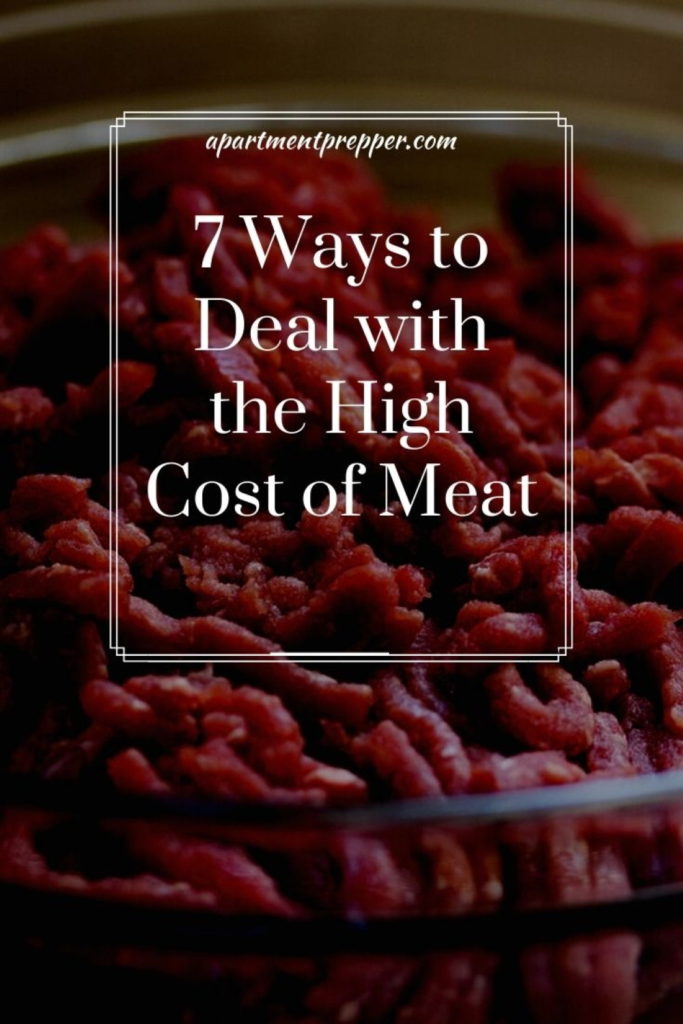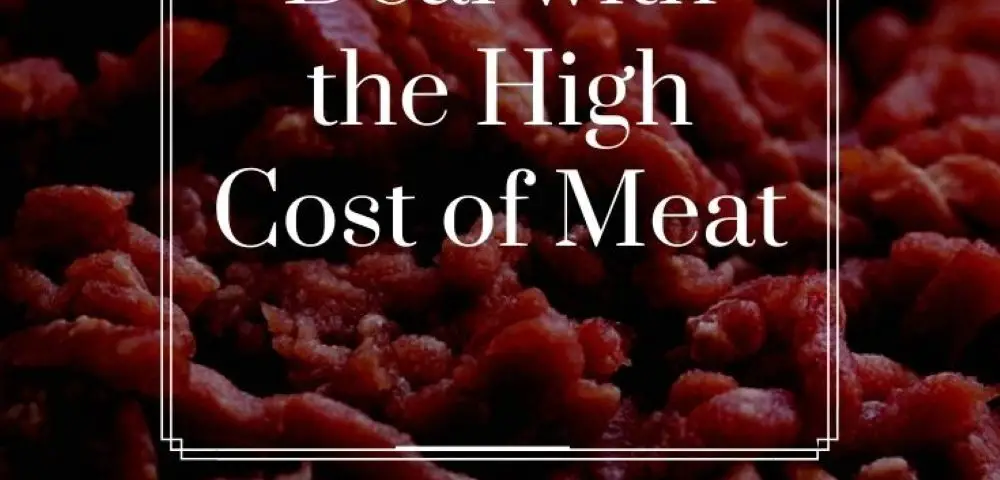Written by Bernie Carr
Meat prices, especially beef, have increased tremendously this year and I am hearing that prices will continue to go up. According to the U.S. Bureau of Labor statistics, protein foods have increased at the percentages below this year:
Pork: 14.1%
Chicken: 8.8%
Fresh fish and seafood: 11%
Eggs: 11.6%
Beef and veal: 20.1%
Those are some huge increases that consumers have to cope with. Below are a few ideas on dealing with the high cost of meat.
Use meat as an ingredient instead of the main dish
Instead of cooking a whole steak or chicken breast with a side of veggies for each person, use just one piece of meat as an ingredient among others such as making stir fry dishes, soups, pasta or casseroles. You can get away with using just one steak or half a pound of ground beef to make a dish for the whole family, instead of four steaks for a family of four.
Stretch it
My Dad adds a handful of bread crumbs to burgers or meat loaf and no one notices the difference. You can also try adding oatmeal, grated vegetables or rice when making meatballs. Fillers actually makes the dish taste better. I make burgers using just a half pound of ground beef and mix it with shredded cheese and jalapenos. The burgers are flavorful and everyone likes the novelty of having ingredients mixed in with the meat.
Calculate the bone-in or boneless price
I have been wondering if it’s more cost-effective to buy meat with the bone or without. Bone-in is usually cheaper but the bone is usually tossed, unless you make soup. I saw this Butcher’s Secret for Getting the Best Meat Prices:
Here’s the secret:
- Chicken with bones: multiply the price by 1.5 to get the boneless equivalent
- Pork with bones: multiply the price by 1.2
- Beef with bones: multiply the price by 1.25
- Hamburger (80% lean): multiply the price by 1.2 to get the actual price per pound (you won’t be eating the 20% fat, right?)
Source: BrownThumbMama
Compare the resulting calculation with the price of the boneless version, and now you can tell which is actually cheaper for you.
Buy what’s on sale
Every week, grocery stores publish their sales and loss leaders. Instead of waiting for grocery fliers, I check online and compare prices. Before you leave for the store, download the coupons so you can print or save. If you have the grocery store app on your phone or have the rewards card, the coupon will be saved on your account. Sometimes the deal is automatic, or other times, you have to download the coupon so read the fine print.
I visit the grocery chain that has the most deals on what I am looking for.
Find clearance items
Clearance items are often not advertised, but are offered in-store. Keep your eye’s open when you visit the meat department and look for the “manager’s special.” These are the items that are marked down to clear them out as they may be close to expiration, or just didn’t sell well.
Separate the meat before freezing
Instead of freezing the meat in the package it came in, I divide up the meat into small portions and repackage them in self-sealing (aka Zip-lock) bags. Or you can repackage meat using a food-sealer. The reason this is economical is it allows you to thaw out the smallest amount. If you leave the meat in the original packaging you may end up thawing too much. Check out this article on whether it’s safe to refreeze thawed meat.
Here’s what the USDA says about refreezing thawed meat:
If raw or cooked food is thawed in the refrigerator, it is safe to refreeze it without cooking or heating, although there may be a loss of quality due to the moisture lost through thawing. After cooking raw foods that were previously frozen, it is safe to freeze the cooked foods. And if previously cooked foods are thawed in the refrigerator, you may refreeze the unused portion. Do not refreeze any foods left outside the refrigerator longer than 2 hours. If you purchase previously frozen meat, poultry or fish at a retail store, you can refreeze if it has been handled properly.
SOURCE: askUSDA.gov
Use a reduced portion from what the recipe recommends
I started reducing the amount of meat that the recipe recommends. Many recipes state a specific amount such as one pound of meat, but I have been experimenting with using less. For example, my lasagna recipe states using one pound of meat, but reduced it to half pound and no one complained.
There are a lot of other ways to cope with the high price of meat. Share your tips in the comments – we can all use these ideas.
We are an affiliate of Amazon.com, which means we received a small commission if you click through one of our Amazon links when you shop, at totally no cost to you. This helps keep the lights on at the blog. Thanks!
Give the gift of prime:Bernie Carr is the founder of Apartment Prepper. She has written several books including the best-selling Prepper’s Pocket Guide, Jake and Miller’s Big Adventure, The Penny-Pinching Prepper and How to Prepare for Most Emergencies on a $50 a Month Budget. Bernie’s latest e-book, FRUGAL DIY has just been released on Amazon. Her work appears in sites such as the Allstate Blog and Clark.com, as well as print magazines such as Backwoods Survival Guide and Prepper Survival Guide. She has been featured in national publications such as Fox Business and Popular Mechanics. Learn more about Bernie here.




Using meat as a flavoring, not as the star of the meal unless it’s Sunday, is actually historically correct as well as thrifty. While the butcher in the grocery store may roll their eyes when asked for one pork chop, you are paying for the product and should be able to order what you can afford, so don’t be afraid to ask to have something cut or repackaged. All they can do is say no, in which case you vote with your feet for another store if there’s one nearby, or even a dedicated butcher shop where you get to know them and they’ll save you bones and things, or offer cuttings left from a larger order.
Adding mushrooms or sauces can sort of distribute the taste around a large pot of food. We recently made a whole stockpot of rice with three chopped up oven baked and well seasoned chicken breasts, a few teaspoons of chicken soup base, mushroom gravy and about two pounds of mixed vegetables. The end product tastes just like a more expensive chicken dish and made 15 good servings, not a bad yield. Making the gravy with dried or fresh milk boosts the protein, and a dish like this is a great way to get veggies into people who otherwise insist on a much more expensive meat entrée.
While I sometimes wish we could still make a third of our meal a piece of meat as we used to, it’s great fun to share tips for making the proteins go further while introducing new tastes. One forum I’m on recently had a thread on how to make a can of corned beef hash feed a family. It ended up running to 14 pages, and I learned some new tricks – not bad for a person who’s been eating corned beef hash for 55 years. Thanks for the great tips!
Mme Homebody, We love corned beef hash! I’ll have to find ways to stretch the one can though, 4 people is the max so far. My brother has been doing the gravy idea lately. Every is trying to stretch their meat budget these days. Thanks for the comment!
Yes, let’s accept shortages and high prices as the new normal. It’s an opportunity to show everyone how we can live like people in 1860. We use too much electricity. We don’t need washing machines, dryers or A/C. Let’s look at sky high prices of gas as a golden opportunity to ride bikes in the rain and heat. The idea of living in a country like Venezuela is extremely appealing. The chances to learn new things to survive, a thrilling prospect.
Not giving up on meat, or any of those other cutbacks in lifestyle, just trying to live within our means. Thanks for the comment.
How about instead of cutting back on meat and adding it as crumbs to our stirfry, which is what liberal socialists want, we get rid of the socialists so our prices will correct themselves. They are killing America.
PS. I don’t Facebook/Meta, I don’t tweet and never have, I don’t Instagram and never have and I get along just fine…. conservatives do not need these or any other WOKE companies. Please talk with your wallet and we can and will turn this country around.
Merry Christmas and God Bless
Agreed, money talks, so use the wallet to signal your dissatisfaction with the system. Thanks for the comment.
I’ve added oatmeal to burger patties. It was delicious.
We survived the great depression. The U.S. has a severe Obesity problem. A large percentage of us need to lose some weight. If we eat less ;we’ll save money.
Hi Jonescrusher, I’ve used bread crumbs, but oatmeal sounds good too. Thanks for the idea.